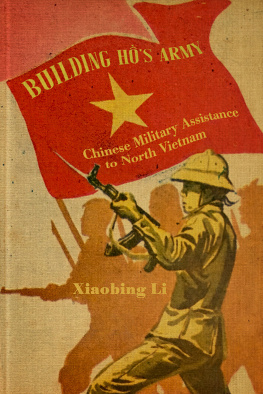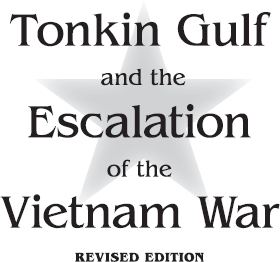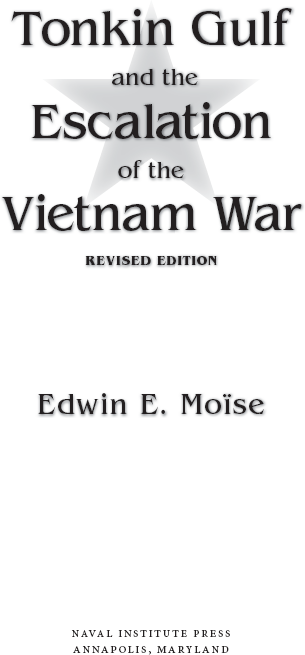
NAVAL INSTITUTE PRESS
291 Wood Road
Annapolis, MD 21402
2019 by Edwin E. Mose
All rights reserved. No part of this book may be reproduced or utilized in any form or by any means, electronic or mechanical, including photocopying and recording, or by any information storage and retrieval system, without permission in writing from the publisher.
Library of Congress Cataloging-in-Publication Data
Names: Mose, Edwin E., date, author.
Title: Tonkin Gulf and the escalation of the Vietnam War / Edwin E. Mose.
Description: Revised edition. | Annapolis, MD : Naval Institute Press, 2019. | Includes bibliographical references and index.
Identifiers: LCCN 2018059826 (print) | LCCN 2018061064 (ebook) | ISBN 9781682474488 (ePDF) | ISBN 9781682474488 (ePub) | ISBN 9781682474242 (hardback) | ISBN 9781682474488 (ebook)
Subjects: LCSH: Tonkin Gulf Incidents, 1964. | Vietnam War, 19611975. | BISAC: HISTORY / Military / Vietnam War. | HISTORY / Military / United States.
Classification: LCC DS557.8.T6 (ebook) | LCC DS557.8.T6 M65 2019 (print) | DDC 959.704/345dc23
LC record available at https://lccn.loc.gov/2018059826
 Print editions meet the requirements of ANSI/NISO z39.48-1992 (Permanence of Paper).
Print editions meet the requirements of ANSI/NISO z39.48-1992 (Permanence of Paper).
Printed in the United States of America.
27 26 25 24 23 22 21 20 199 8 7 6 5 4 3 2 1
First printing
Maps created by Chris Robinson.
Book design and composition: Alcorn Publication Design
Contents
Illustrations
MAPS
FIGURES
PHOTOS
Preface
O n the night of August 4, 1964, two U.S. Navy destroyers cruising in the Gulf of Tonkin, off the coast of North Vietnam, reported that they were being attacked by torpedo boats. The United States reacted strongly to this supposed attack on the American flag. On August 5 the United States conducted its first airstrikes against North Vietnam. On August 7 both houses of Congress, in a rush of patriotism, passed the Tonkin Gulf Resolution giving President Lyndon B. Johnson the authority to take all necessary measures to prevent further aggression. When the Johnson administration sent large American military forces to Vietnam in the following years, it cited this resolution as having given it the authority to do so.
In 1967, first a few journalists and then some senators began to question whether the two destroyers had actually been attacked that night. Three major books claiming that no attack had occurred appeared between 1969 and 1971, but the authors could not really prove their case. They were heavily dependent on interviews because hardly any of the relevant documents had been declassified, and the eyewitnesses were split. Some doubted that there had been an attack; others were sure the attack had been real.
Today, with a much wider range of evidence available, it is clear that no actual attack occurred. On a dark night in poor weather, the radar had been playing tricks, showing ghost images that the men on the destroyers mistakenly interpreted as hostile vessels.
The incorrect report of August 4 did not really cause the outbreak of large-scale war in Vietnam. By August 1964 Washington and Hanoi were already on a collision course. The level of combat in South Vietnam and the level of outside support on both sides were increasing. The United States was sponsoring a program of covert operations against North Vietnam that had so aroused the navy of the Democratic Republic of Vietnam (DRV) that three DRV torpedo boats had made a genuine attack on a U.S. destroyer two days earlier, on the afternoon of August 2. The August 2 incident had left some Americans expecting the North Vietnamese to attack U.S. ships, and thus set the stage psychologically for the mistaken report of an attack on the night of August 4.
If reports from the Gulf of Tonkin had not caused President Johnson to order airstrikes against North Vietnam in August 1964, something else would have done so within a few months. Some other excuse could have been found to persuade Congress to pass a resolution giving the president the authority to take the actions he felt necessary; the administration had begun writing drafts of that resolution well before the Tonkin Gulf incidents.
Despite this, the Tonkin Gulf incidentsthe real one of August 2 for which the United States did not retaliate and the imaginary one of August 4 that provoked the airstrikes and the Tonkin Gulf Resolutiondeserve careful attention for at least five reasons.
. If we wish to understand the pattern of forces that made a collision between Washington and Hanoi inevitable, we can derive valuable clues from a look at the incident that actually did lead to the first direct collision.
. To say that a collision was inevitable is not to say that its results were inevitable. If the first U.S. airstrikes against North Vietnam had happened a few months later in retaliation for some other incident, the circumstances would have been different and the long-term consequences might have been very different. In this sense it is possible to argue that the mistaken report of August 4 did change the course of history.
. Those who argue that it makes little difference whether there was really an attack on the two destroyers on August 4 are thinking only of evaluating U.S. behavior. The pattern of U.S. policy indeed looks about the same whether one believes that the United States bombed North Vietnam on August 5 as a result of an attack on U.S. destroyers or only as a result of a mistaken belief that there had been such an attack. The same does not apply, however, to North Vietnamese policy. In one version, the DRV was so eager to start a fight that it sent naval vessels sixty miles out from its coast to attack two U.S. ships. In the other, the DRV, having had more sense than to do such a thing, was falsely accused of having done so and was bombed in retaliation for the imaginary attack, under circumstances that would have left the DRV convinced that the United States had concocted the imaginary incident deliberately in order to provide an excuse for escalation. The DRVs moves during the following months would have been shaped by this belief. The difference between these two pictures of DRV policy is not trivial.
. These incidents teach interesting lessons on the limits of signals intelligence. It is tempting to assume that if you are listening to the enemys radio communications you know what the enemy is doing and thinking. This was far from the case for the United States in August 1964. In 2005 and 2006 the National Security Agency (NSA) declassified and released a large body of intercepted North Vietnamese radio messages and related documents dealing with the Tonkin Gulf incidents. There were no big surprises with regard to the imaginary attack of August 4. As a number of officers had told me years earlier, the intercepts made it pretty clear that there had been no North Vietnamese attack against the American destroyers that night. The claims that had been made over the years that the intercepts provided evidence of an attack had been based on a very selective and heavily biased reading of them. But the intercepts regarding the genuine incident of August 2 were startling. I had expected to find in them a reasonably clear picture of the North Vietnamese attack on the
Next page












 Print editions meet the requirements of ANSI/NISO z39.48-1992 (Permanence of Paper).
Print editions meet the requirements of ANSI/NISO z39.48-1992 (Permanence of Paper).